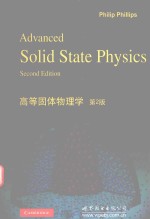

高等固体物理学 第2版PDF电子书下载
- 电子书积分:14 积分如何计算积分?
- 作 者:菲利普斯(PhilipPhillipsP.)著
- 出 版 社:北京/西安:世界图书出版公司
- 出版年份:2015
- ISBN:9787510097980
- 页数:402 页
1 Introduction 1
1.1 Spontaneously broken symmetry 1
1.2 Tracking broken symmetry:order parameter 4
1.3 Beyond broken symmetry 7
References 9
2 Non-interacting electron gas 10
Problems 15
3 Born-Oppenheimer approximation 16
3.1 Basic Hamiltonian 16
3.2 Adiabatic approximation 17
3.3 Tight-binding approximation 20
Problem 22
References 23
4 Second quantization 24
4.1 Bosons 24
4.2 Fermions 26
4.3 Fermion operators 27
Problems 30
References 30
5 Hartree-Fock approximation 31
5.1 Non-interacting limit 31
5.2 Hartree-Fock approximation 33
5.3 Diagrams 35
Problem 36
References 36
6 Interacting electron gas 37
6.1 Uniform electron gas 38
6.2 Hartree-Fock excitation spectrum 40
6.3 Cohesive energy of metals 42
Summary 48
Problems 48
References 49
7 Local magnetic moments in metals 51
7.1 Local moments:phenomenology 51
7.2 Impurity density of states 54
7.3 Green functions 60
7.4 Friedel's sum rule and local moments 70
Summary 74
Appendix to Chapter 7:Luttinger's theorem 74
Problems 79
References 79
8 Quenching of local moments:the Kondo problem 80
8.1 The Kondo Hamiltonian 82
8.2 Why is J negative? 83
8.3 Scattering and the resistivity minimum 87
8.4 Electron-impurity scattering amplitudes 94
8.5 Kondo temperature 99
8.6 Poor Man's scaling 102
Summary 109
Appendix to Chapter 8:the Schrieffer-Wolff transformation 109
Problems 113
References 114
9 Screening and plasmons 115
9.1 Thomas-Fermi screening 115
9.2 Plasma oscillations and collective coordinates 117
9.3 Linear response theory 122
9.4 Dielectric response function 127
9.5 Kubo formula:electrical conductivity 137
9.6 Stopping power of a plasma 140
Summary 143
Problems 144
References 145
10 Bosonization 146
10.1 Luttinger liquid 146
10.2 Bosonization of Luttinger model 151
10.3 Pair binding:can electrons do it alone? 160
10.4 Excitation spectrum 162
Summary 167
Problems 167
References 168
11 Electron-Iattice interactions 169
11.1 Harmonic chain 169
11.2 Acoustic phonons 171
11.3 Electron-phonon interaction 172
11.4 Ultrasonic attenuation 176
11.5 Electrical conduction 178
Summary 187
Problems 187
References 188
12 Superconductivity in metals 189
12.1 Superconductivity:phenomenology 189
12.2 Electron-phonon effective interaction 197
12.3 Model interaction 199
12.4 Cooper pairs 201
12.5 Fermi liquid theory 205
12.6 Pair amplitude 216
12.7 BCS ground state 221
12.8 Pair fluctuations 224
12.9 Ground state energy 226
12.10 Critical magnetic field 229
12.11 Energy gap 231
12.12 Quasi-particle excitations 233
12.13 Thermodynamics 237
12.14 Experimental applications 241
12.15 Josephson tunneling 253
Summary 255
Problems 255
References 257
13 Disorder:localization and exceptions 258
13.1 Primer on localization 259
13.2 Return probability:localization criterion 261
13.3 Weak localization 264
13.4 Scaling theory 269
13.5 Exceptions to localization 275
Summary 285
Problems 286
References 287
14 Quantum phase transitions 289
14.1 Quantum rotor model 291
14.2 Scaling 293
14.3 Mean-field solution 296
14.4 Landau-Ginsburg theory 302
14.5 Transport properties 306
14.6 Experiments 308
14.7 Scaling and T-linear resistivity 310
Problems 314
References 314
15 Quantum Hall and other topological states 317
15.1 What is the quantum Hall effect? 317
15.2 Landau levels 320
15.3 The role of disorder 324
15.4 Currents at the edge 326
15.5 Topological insulators 330
15.6 Laughlin liquid 343
Summary 349
Problems 349
References 350
16 Electrons at strong coupling:Mottness 353
16.1 Band insulator 354
16.2 Mott's problem 357
16.3 Much ado about zeros:Luttinger surface 363
16.4 Beyond the atomic limit:Heisenberg versus Slater 368
16.5 Dynamical spectral weight transfer 380
16.6 Epilogue:1=2-1 396
Problems 397
References 398
Index 400
- 《新编高中物理竞赛教程习题全解》钟小平主编;钟小平,倪国富,曹海奇编写 2019
- 《数学物理方法与仿真 第3版》杨华军 2020
- 《中学物理奥赛辅导:热学 光学 近代物理学》崔宏滨 2012
- 《长江口物理、化学与生态环境调查图集》于非 2019
- 《大学物理简明教程 下 第2版》施卫主编 2020
- 《慢性呼吸系统疾病物理治疗工作手册》(荷)瑞克·考斯林克(RikGosselink) 2020
- 《医学物理学》洪洋 2020
- 《初中物理知识地图》赵端旭 2017
- 《教师教育系列教材 心理学原理与应用 第2版 视频版》郑红,倪嘉波,刘亨荣编;陈冬梅责编 2020
- 《高等医药院校教材 医学物理学实验指导》(中国)杨晓岚 2019
- 《中风偏瘫 脑萎缩 痴呆 最新治疗原则与方法》孙作东著 2004
- 《水面舰艇编队作战运筹分析》谭安胜著 2009
- 《王蒙文集 新版 35 评点《红楼梦》 上》王蒙著 2020
- 《TED说话的力量 世界优秀演讲者的口才秘诀》(坦桑)阿卡什·P.卡里亚著 2019
- 《燕堂夜话》蒋忠和著 2019
- 《经久》静水边著 2019
- 《魔法销售台词》(美)埃尔默·惠勒著 2019
- 《微表情密码》(波)卡西亚·韦佐夫斯基,(波)帕特里克·韦佐夫斯基著 2019
- 《看书琐记与作文秘诀》鲁迅著 2019
- 《酒国》莫言著 2019
- 《TED说话的力量 世界优秀演讲者的口才秘诀》(坦桑)阿卡什·P.卡里亚著 2019
- 《小手画出大世界 恐龙世界》登亚编绘 2008
- 《近代世界史文献丛编 19》王强主编 2017
- 《课堂上听不到的历史传奇 世界政治军事名人 初中版》顾跃忠等编著 2015
- 《指向核心素养 北京十一学校名师教学设计 英语 七年级 上 配人教版》周志英总主编 2019
- 《365奇趣英语乐园 世界民间故事》爱思得图书国际企业 2018
- 《近代世界史文献丛编 36》王强主编 2017
- 《北京生态环境保护》《北京环境保护丛书》编委会编著 2018
- 《近代世界史文献丛编 11》王强主编 2017
- 《近代世界史文献丛编 18》王强主编 2017
